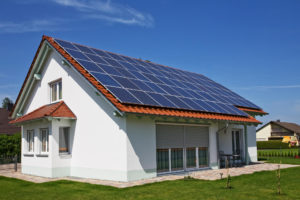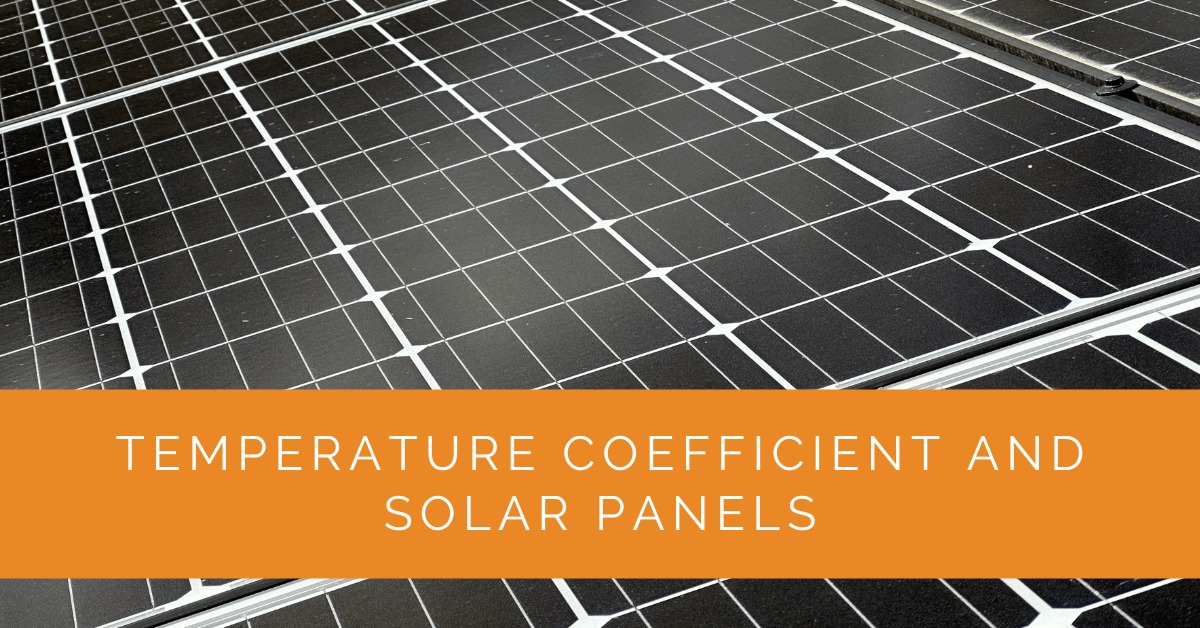Understanding the factors that influence solar panel efficiency becomes crucial in harnessing solar energy to its maximum potential. One such factor is the temperature coefficient, which plays a significant role in the performance of solar panels. This article sheds light on the relationship between temperature and solar panels, focusing on the temperature coefficient and its impact on module efficiency.
Contents
- 1 Key Takeaways
- 2 Understanding Solar Panels
- 3 The Temperature Coefficient of PV Modules
- 4 Effect of Temperature on Solar Panel Performance
- 5 Optimizing Solar Panel Performance
- 6 Case Study: Mitigating the Impact of Temperature on Solar Panel Efficiency
- 7 Expert Insights From Our Solar Panel Installers About Temperature Coefficient and Solar Panels
- 8 Experience Solar Excellence with Us!
- 9 Conclusion
Key Takeaways
- Understanding the temperature coefficient of solar panels is crucial for evaluating the impact of temperature on power output, allowing for selecting panels with favorable coefficients and minimizing power losses.
- Temperature fluctuations can significantly affect solar panel performance, reducing power output and potential long-term degradation, emphasizing the importance of effective monitoring, maintenance, and thermal management strategies.
- Optimizing solar panel performance involves selecting panels with favorable temperature coefficients, implementing monitoring and maintenance practices, and employing advanced system designs to maximize power output, efficiency, and the overall longevity of the system.
Understanding Solar Panels
Solar panels, or photovoltaic (PV) modules, are sophisticated devices designed to capture sunlight and convert it into usable electrical energy. These panels consist of interconnected solar cells typically made of semiconducting materials like silicon. When sunlight hits the solar cells, they absorb photons, releasing electrons and generating an electrical current through the photovoltaic effect.
The Role of Solar Cells in PV Modules
Solar cells are the fundamental building blocks of PV modules. They are responsible for the direct conversion of sunlight into electricity. Each solar cell comprises layers of semiconducting materials, such as silicon, that possess unique electrical properties. When photons strike the solar cell’s surface, they excite electrons, causing them to break free from their atomic bonds and create a flow of current. This generated electricity is then collected and used to power various applications.
Components and Construction of PV Modules
PV modules consist of interconnected solar cells encapsulated within a protective housing. These modules are designed to withstand the rigors of outdoor environments and efficiently capture solar energy. The cells are typically connected in series and parallel configurations to achieve the desired voltage and current output. Additionally, PV modules feature a front surface made of tempered glass, which protects the cells from external elements while maximizing light transmission. They also incorporate a back sheet and frame to provide structural support and protect against moisture ingress.
The Temperature Coefficient of PV Modules
Understanding the Impact of Temperature on Solar Panel Performance
The temperature coefficient is a crucial parameter that helps evaluate how temperature changes affect PV modules’ performance. It measures the percentage change in power output per degree Celsius temperature variation. Expressed as a percentage per degree Celsius (%/°C), the temperature coefficient provides valuable insights into how solar panel efficiency is influenced by fluctuations in temperature.
Exploring Temperature Coefficient
The temperature coefficient of PV modules represents the relationship between temperature and power output. It quantifies the change in electrical performance in response to temperature changes. Positive temperature coefficients indicate that as temperature increases, the solar panel’s power output decreases. Conversely, negative temperature coefficients suggest that as the temperature rises, the power output increases.
Understanding the Voltage Temperature Coefficient
Within the temperature coefficient, the voltage temperature coefficient specifically focuses on the effect of temperature on the voltage output of solar panels. It indicates the rate at which the panel’s voltage decreases with increasing temperature. A higher voltage temperature coefficient means that the panel’s voltage output decreases more rapidly with rising temperatures.

Effect of Temperature on Solar Panel Performance
Unraveling the Impact of Temperature on Solar Panel Efficiency
Temperature fluctuations can significantly impact the performance and efficiency of solar panels. Understanding these effects is crucial for optimizing solar energy generation and maximizing system output.
Solar Panel Temperature
Various factors, including ambient temperature, solar irradiance, panel orientation, and heat dissipation, influence solar panels’ temperature. While solar panels ideally operate at around 25°C, real-world conditions often result in deviations from this optimal temperature. Panels exposed to high ambient temperatures, direct sunlight, or inadequate ventilation can experience elevated temperatures, potentially affecting their performance.
Power Output Reduction due to Increased Resistance
As temperature increases, the resistance within the solar cells also rises. This increased resistance hinders the flow of electrons, resulting in a decrease in power output. The power loss due to elevated resistance can be significant, impacting the overall efficiency of the solar panel system. Therefore, it is essential to consider the effects of temperature on power output when designing and implementing solar energy systems.
Shifting the Maximum Power Point (MPP)
The maximum power point (MPP) represents the operating point at which a solar panel generates the maximum power. However, as temperatures deviate from the optimal range, the MPP shifts, reducing power output. This shift results from the changes in the electrical characteristics of the solar cells under different temperature conditions. Considering this temperature-induced MPP shift when designing solar panel systems is crucial to ensure maximum energy harvest.
Moreover, high temperatures can also accelerate the degradation of materials used in solar panels, potentially shortening their lifespan. Heat-induced stresses, such as thermal expansion and contraction, can affect the structural integrity of the panels over time. Therefore, managing temperature effectively is important for immediate power output and the long-term reliability and durability of solar panel systems.

Optimizing Solar Panel Performance
Optimizing the performance of solar panels requires a comprehensive approach that considers various factors. Solar panel owners can maximize power output and improve overall system efficiency by implementing the following strategies.
Selecting Panels with Favorable Temperature Coefficients
When choosing solar panels, it is essential to consider the temperature coefficient as a decisive factor. When exposed to high temperatures, panels with lower temperature coefficients experience minimal power losses. By selecting panels with favorable temperature coefficients, system owners can mitigate the negative effects of temperature on power output, ensuring consistent performance even in challenging climatic conditions.
Implementing Effective Monitoring and Maintenance
Regular monitoring and maintenance play a crucial role in optimizing solar panel performance. Monitoring systems can track parameters such as panel temperature, irradiance levels, and energy production. System owners can promptly detect deviations or anomalies by closely monitoring these factors. This allows timely intervention and troubleshooting to minimize power losses and ensure efficient operation.
In addition to monitoring, routine maintenance practices are vital to keeping solar panels in optimal condition. Regular inspections help identify any physical damage, such as cracks or corrosion, which can affect performance. Furthermore, proper cleaning of panels removes dust, dirt, and debris that can accumulate over time, optimizing light absorption and maximizing energy conversion efficiency.
Employing Thermal Management Techniques
Effective thermal management techniques can help regulate the temperature of solar panels and minimize the impact of heat on performance. Some strategies include proper panel mounting and airflow optimization to facilitate heat dissipation. System owners can maintain lower operating temperatures by ensuring adequate ventilation, preventing excessive heat buildup, reducing power losses, and enhancing overall efficiency.
Implementing Advanced System Designs
Innovative system designs can also contribute to optimizing solar panel performance. Advanced technologies such as bypass diodes and maximum power point tracking (MPPT) algorithms can help mitigate the impact of temperature-induced power losses. Bypass diodes enable effective current flow, bypassing shaded or malfunctioning cells, while MPPT algorithms dynamically adjust the operating conditions of the panels to extract the maximum available power.
These advanced system designs and technologies allow solar panel systems to adapt to changing temperature conditions, maximizing power output and overall energy generation.
Case Study: Mitigating the Impact of Temperature on Solar Panel Efficiency
Background
At Solar Panels Network USA, we strive to provide optimal solar energy solutions by addressing critical factors affecting solar panel performance. One such factor is the temperature coefficient, which significantly influences the efficiency of solar panels in varying climatic conditions. This case study highlights our approach to managing temperature-related challenges to maximize energy output and system longevity.
Project Overview
A commercial client approached us with concerns about the declining efficiency of their solar panel system during hot summer months. Their existing panels experienced substantial power losses due to high temperatures, impacting overall energy production. Our goal was to optimize their solar panel system to mitigate temperature-induced performance drops.
Implementation
- Consultation and Assessment: We began with a comprehensive assessment of the client’s solar panel system, focusing on the temperature coefficient of the installed panels and the local climatic conditions. This evaluation helped us understand the extent of the impact of high temperatures on their energy output.
- Selection of Panels with Favorable Temperature Coefficients: Based on our assessment, we recommended upgrading to solar panels with lower temperature coefficients. These panels exhibit minimal power losses even under high temperatures, ensuring more consistent energy production throughout the year.
- Thermal Management Techniques: We implemented advanced thermal management strategies to regulate the temperature of the solar panels. Proper panel mounting and airflow optimization facilitated effective heat dissipation. Ensuring adequate ventilation helped maintain lower operating temperatures, preventing excessive heat buildup and reducing power losses.
- Advanced System Designs: To further enhance the system’s efficiency, we integrated advanced technologies such as bypass diodes and maximum power point tracking (MPPT) algorithms. Bypass diodes enabled effective current flow by bypassing shaded or malfunctioning cells, while MPPT algorithms dynamically adjusted the panels’ operating conditions to extract the maximum available power.
Results
The implementation of these strategies led to a significant improvement in the solar panel system’s performance. The client observed a substantial reduction in temperature-induced power losses, resulting in a marked increase in overall energy production. The system’s efficiency remained consistent even during the hottest months, ensuring reliable energy output.
Summary
Addressing the impact of temperature on solar panel efficiency is crucial for optimizing energy production and system longevity. At Solar Panels Network USA, we employ comprehensive strategies, including selecting panels with favorable temperature coefficients, implementing effective thermal management techniques, and utilizing advanced system designs. This case study demonstrates our commitment to providing reliable and efficient solar energy solutions tailored to our clients’ unique environmental challenges.
Expert Insights From Our Solar Panel Installers About Temperature Coefficient and Solar Panels
Understanding the temperature coefficient is crucial because it directly impacts the efficiency of your solar panels. High temperatures can significantly reduce power output, making it essential to choose panels with favorable coefficients.
Senior Solar Installer
Regular monitoring and maintenance are vital for optimizing solar panel performance. By tracking temperature fluctuations and addressing any issues promptly, we can ensure that the panels operate efficiently even in varying climatic conditions.
Lead Installation Technician
Implementing advanced thermal management techniques helps mitigate the negative effects of high temperatures. Proper ventilation and innovative designs like bypass diodes and MPPT algorithms can significantly enhance overall system efficiency.
Certified Solar Installation Expert
Experience Solar Excellence with Us!
Trust in Solar Panels Network USA, where our seasoned experts deliver top-quality solar solutions for homes and businesses nationwide. With a legacy of countless successful installations and a commitment to sustainable energy, we’re your reliable partner in the solar journey. Ready for a brighter, eco-friendly future? Call us now at (855) 427-0058 and harness the power of the sun!
Conclusion
The temperature coefficient is a key factor in understanding the impact of temperature on solar panel efficiency. Solar panel owners can optimize power output and maximize energy generation by selecting panels with favorable temperature coefficients and implementing regular monitoring and maintenance practices. With careful consideration and proactive measures, we can harness the full potential of solar energy for a sustainable future.
About the Author
Solar Panels Network USA stands at the forefront of solar energy solutions, driven by a team of seasoned solar engineers and energy consultants. With over decades of experience in delivering high-quality solar installations and maintenance, we are committed to promoting sustainable energy through customer-centric, tailored solutions. Our articles reflect this commitment, crafted collaboratively by experts to provide accurate, up-to-date insights into solar technology, ensuring our readers are well-informed and empowered in their solar energy decisions.

